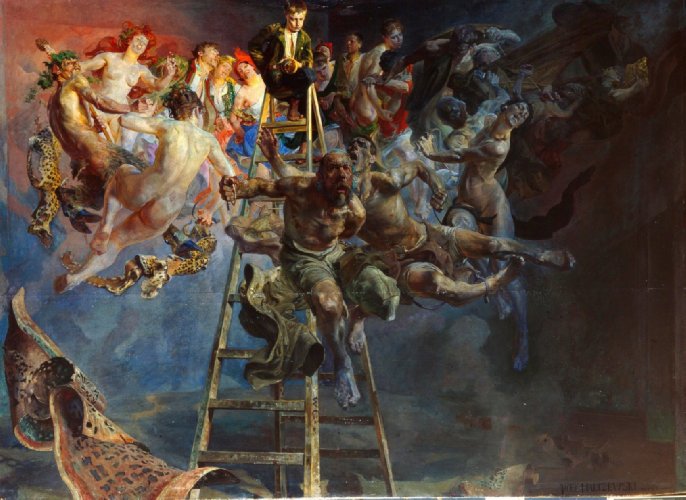Description:
Jacek Malczewski (1854-1929) had a love for art and romantic literature, particularly the poetry of Juliusz Słowacki, which he inherited from his family. He came from a noble but not wealthy family. His father Julian supported him in his career as a painter. The events of 1863, the January Uprising and subsequent repression, had a particular impact on the young artist. His first teacher was Adolf Dygasiński. He spent his teenage years (1867-1871) at the Karczewski family manor in Wielgie. In 1873 he started studying at the Academy of Fine Arts in Krakow under the tutelage of Jan Matejko. He was a student of Władysław Łuszczkiewicz and also studied at the École des Beaux-Arts in Paris. He traveled to Italy, Vienna, Munich, Greece and Asia Minor. From 1896 to 1900 and 1910 to 1914 he was a professor at the Academy of Fine Arts in Krakow. From 1912 to 1914 he was its rector. He began with a romantic realism, then a naturalism, with the theme of exiles to Siberia and inspirations from Juliusz Słowacki’s “Anhellim” prevalent in his works of this period. At the same time, fantastic and allegorical elements began to appear in Malczewski’s works. After his father’s death in 1884, the recurring theme in Malczewski’s work was Thanatos – the god of death. After 1890 his art became completely symbolic. Works manifesting the turn towards Symbolist style include: “Introduction” 1890, “Melancholy” 1890-1894, “Vicious Circle” 1895-1897. The artist tackled existential, historical and art-related issues, intertwining classical and biblical motifs with native folklore and the quintessential Polish landscape in his works. Form, color, monumentality of representation and expressiveness became his distinctive features.
Description of the painting:
“Vicious Circle” is another manifesto work in Malczewski’s oeuvre. It is considered one of the most important works of modern Polish art. On the one hand, it is an allegory of life, on the other – it refers to the cognitive sphere of man, his creative and effective power *.
This time the figure experiencing the vision is a young man sitting on a ladder with a brush in his hand. He is not a great artist, but rather a beginner of a room painter, as it may seem. At the foot of the ladder are paper samples. The circle of surrounding figures has a clearly two-part structure. Emphasized by a different color scheme, selection of characters and the emotions that can be seen on their faces. The left part is cheerful. It consists of satyrs, bacchantes, rural girls embodying life. Their physicality tempts with its sensuality, youth, redness and invites to the party. In contrast, the right part of the circle formed by the characters. Captured in a dark color scheme, it presents only exhausted life-forms, in tattered clothes and manacles on their bare feet. A madly almost circle seems to be closed by a figure of an old man shown against the background of the ladder. Pain is visible on his face, a Sybiracki coat has fallen from his shoulders. It is he who the young painter looks at. The man holds a frayed end of the rope, wire, this unique thread of life that connects the unfortunate. It is his that the penitent, suffering phantoms cling to. The circle as a set of characters reflects the eternity of time and the cyclicity of events. In “Vicious Circle” the artist for the first time combined folk, antique-mythological and national-martyrological motifs that had previously been independent of each other *.
The attention is drawn to the dynamism of the composition. Created by a significant pairing of the two parts of the mad circle, expressive movements and poses of the silhouettes forming it. The symbolic dualism is also visible in the opposition of youth, vitality and old age. Joy and exhaustion. Sensuality and suffering. Sensual and historical enslavement. And all seems to be maintained in a relative movement of the figure of the young man. Shown in the center of the presentation, the ladder becomes a symbol of knowledge and overcoming by the young adept of the successive stages of artistic initiation. Sitting on its top, the boy dominates over the other characters. He becomes both their creator and the director of the imaginary performance and the course of human fate. He balances between its two parts and tries to maintain their balance, because he can look at them from a distance and observe the interdependencies between them.
The vision presented by Malczewski was completely subordinated to art, to the artist. Creativity becomes the only right way to perceive the sensory and spiritual side of the reality surrounding us.


